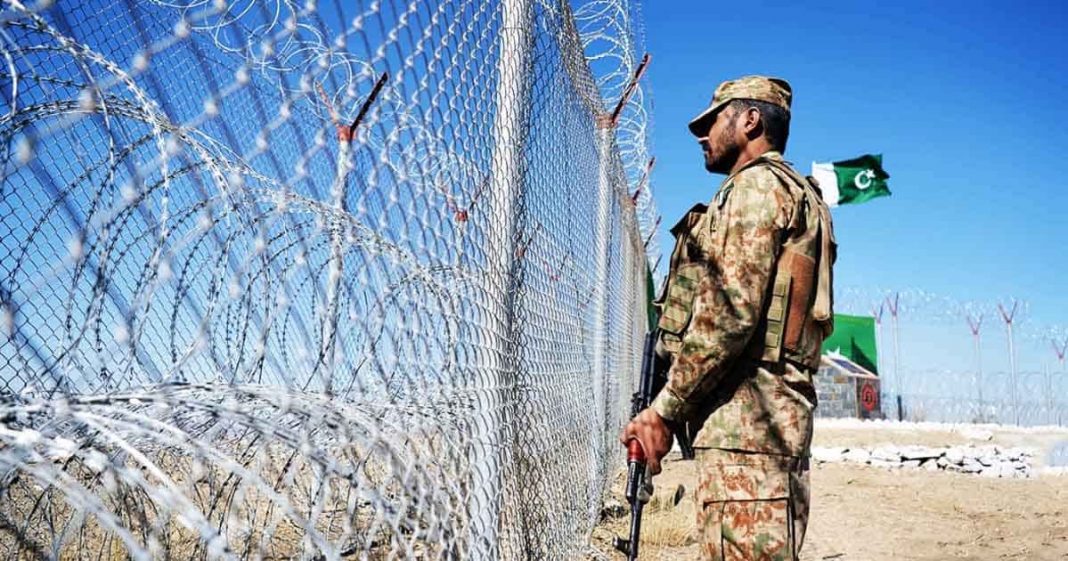The Pak–Afghan barrier is a border fence being built by Pakistan in March 2017 along its 2,670 km long (1,660 mi) border with Afghanistan. On 21 January 2022, Pakistan’s interior minister stated that only a 20 km long patch along this border remains to be fenced.
In 2019, Pakistan decided to fence its832 km border with Iran also. As of mid-2021, Pakistan had fenced 46% of this border, and work on completing the fence is proceeding with full speed.
Read more: Changing Regional Dynamics; Challenges on Pakistan volatile borders amid Afghan anarchy
What is the purpose of fencing Pakistan’s western borders?
The primary purpose of policing the western borders, till 1979, was to prevent drug trafficking, the influx of refugees, illegal immigration, and smuggling. The situation changed in 1979 – a defining year for Pakistan:
On 11th February 1979, the Islamic revolution in Iran swept the shah from power and put in place Ayatollah Khomeini. Though Iran and India had started forging a strategic relationship during the Shah’s rule, relations between Pakistan and Iran remained cordial – they were allies in the US-sponsored Central Treaty Organization (CENTO). The Islamic revolution changed this equation. Henceforth, Pakistan’s border with Iran would not remain inert as it was during the Shah’s rule.
The Soviet Union invaded Afghanistan on the Christmas Eve of 1979. Pakistan, the country which was going to be in the eye of the storm for the next nine years, remained silent, at pains to comprehend the situation before evolving an appropriate response. The Soviet invasion of Afghanistan also activated the Pak- Afghan border.
In 1947, Afghanistan was the only country that opposed Pakistan’s membership in the United Nations. This Afghan hostility, grounded on Afghanistan’s revanchist claims on Pakistani territory adjoining the Pak-Afghan border, has remained a constant factor in the relations between the two countries. The present Taliban regime is no exception. Like their predecessor regimes, the Taliban have also rejected the Durand Line as the international border between Pakistan and Afghanistan.
Read more: Afghan General & Dy.Chief of Staff urges Pakistan to reopen borders
Fencing Pakistan’s western borders is a step in the right direction, but it has two drawbacks:
Locking the Army
The fence, like any natural or man-made obstacle, loses its obstacle value if it is not manned and covered by fire. Originally intended for border policing, the fence has permanently tied down Pakistan Army all along its almost 3000 km length. Two Pakistan Army corps have been deployed, directly or indirectly, for anti-terrorism operations, weaning them away from their primary role i.e. preparing for war with India.
Anti-smuggling, anti-terrorism, and anti-insurgency activities are primarily the duties of para-military forces like the Rangers in Punjab and the Frontier Corps in KPK and Balochistan. However, over the period, these paramilitary forces have been relegated to performing anti-smuggling duties only, that too with poor performance.
During the Soviet invasion of Afghanistan, XI and XII Corps were raised to defend from a likely Soviet Invasion across the Pak-Afghan border. After the Afghan War, these corps were available for operations against India. This is no longer the case as both these corps have been locked in the war against TTP and Baluch separatists. We have unwittingly allowed ourselves to get embroiled in a long-drawn anti-insurgency war that suits India’s designs.
So, with the border fence in place, and X and XI corps having been absorbed in performing the duties of paramilitary forces, we no longer have a strategic defensive balance (strategic reserves) to fight a kinetic war against India. To restore the balance, we will either have to withdraw the formations committed to fighting the insurgency or raise two new army corps. And please let us not delude ourselves that a future kinetic war with India is not an option.
Read more: Repeated Flare-Ups on Indo-Pakistani borders: Pakistanis see an “Agenda”
False Sense of Security
Deployment behind obstacles gives a false sense of security to the defender. The French Maginot Line and the Israeli Bar-Lev Line are apt examples of this weakness. Both these lines were either bypassed or reduced by the attackers (The Germans and the Egyptians, respectively).
Instead of embroiling the Pakistan Army with terrorists launching attacks from Afghanistan and Iran, the army would do better declaring a strip, say 10 km deep across its western borders, as a security zone where movement should be electronically monitored. Any suspected movement should be punished with artillery, heavy weapons, drones, and even fighter aircraft. This is already being done on a limited scale. Let us make it a new normal.
On 16 December 2021, a drone strike hit a house just inside Afghanistan’s border with Pakistan, apparently targeting a senior member of the Pakistani Taliban, but the missile failed to explode. One of the Taliban officials said the drone fired a missile at a hujra, or guesthouse on the compound of Maulvi Faqir Mohammad, a senior leader of the Tehrik-e Taliban Pakistan movement (TTP).
Read more: Legacy of Pakistan’s Army Chief General Qamar Bajwa
Pakistan Army, in the recent past, has conducted fire raids in Afghan border areas where it employed artillery and heavy weapons. The forays into Afghanistan did not result in any potent Taliban reaction- they don’t have any matching option. The same is true in the case of Iran. If BLA and other Iranian proxies can attack the Pakistan Army check posts from their hideouts inside Iran, why cannot Pakistan Army retaliate in kind? Bleeding slowly is also not an option for Pakistan.
Saleem Akhtar Malik is a Pakistan Army veteran who writes on national and international affairs, defense, military history, and military technology. He Tweets at @saleemakhtar53. The views expressed in this article are the author’s own and do not necessarily reflect the editorial policy of Global Village Space.














